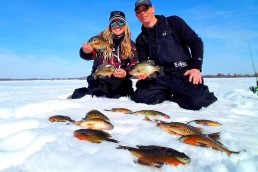Late Fall Sets the Stage for Early-Ice Crappies
SHARE THIS POST
Dave Csanda shares some tips on finding crappies in mid-depth basins during the transition from late fall to early winter ice.
The transition from late fall to early winter is prime time for catching crappies, although there are inherent challenges. Bouncing around in waves while trying to fish small lures in deep water isn’t easy; calm conditions are much easier to fish. And taking those first few tentative steps out onto newly formed ice is both exhilarating and nerve wracking, until the ice thickens to a confidently safe surface. Yet both situations—which are basically the same situation, just with or without ice—have excellent potential.
For crappies, basically forget about fishing anything deeper than 40 feet in nearly all situations. In clear to moderately clear natural lakes, basins and/or structural edges with 25 to 40 feet of depth lie in a good target range for late-fall and winter crappies. In stained or darker-water lakes, those depth ranges may be shallower.
Oxygen levels are consistent throughout the water column at this time of year. Crappies are likely to be within a few feet of the bottom. By midwinter, deteriorating oxygen levels and reduced sunlight penetration due to snow cover typically cause crappies to rise higher off bottom, suspending at mid-levels.
The trick is to find mid-depth basins or flats that draw fish. These areas can be near or far from structure, depending on what’s available.
In shallow lakes with basins less than 40 feet deep, crappies may simply patrol the basin in late fall and early winter, seeking or following schools of minnows, or feeding on insect larvae in or emerging from the mud. Fish can bite at any time of day, but they often display increased feeding activity after sunset. Reduced light levels cause all manner of tiny critters to emerge from soft bottoms, permitting crappies feed on them.
Are you enjoying this post?
You can be among the first to get the latest info on where to go, what to use and how to use it!
In deeper lakes, you can pretty much eliminate areas deeper than 40 feet. Find areas of perhaps 25 to 40 feet in depth that attract crappies. These occur in several forms.
- Bays having basins with correct depths—Fish bays with perhaps 20 to 30 feet of depth in their centers. Because they’re separated from the deeper main lake, they should cool faster and freeze up earlier, providing early foot access to good fishing spots.
- Main-lake sections with correct depths—Some lakes have 50- to 100-foot-deep sections. Ignore those portions of the lake for crappies. Focus instead on areas with shallower basins.
- Mid-depth flats adjacent to structure—If the previous areas are scarce or absent, look instead for smaller mid-depth flats adjacent to bay mouths, points, weed beds and shallow offshore humps. While crappies can patrol right along a deep weed edge or move up on top of a point or hump, they are more likely to patrol the softer-bottom flat adjacent to it.
Crappies patrol these mid-depth flats. Drill lots of holes, or scan with electronics, to determine general areas with fish activity. Expect flurries of bites as schools of fish pass beneath your hole, followed by lulls as they proceed on their route.
Open-water tackle—It’s hard to fish tiny, lightweight lures in deep water, particularly in windy conditions. Your baits need a little weight; go with 1/8- vs. 1/16-ounce jigs. Better yet, try vertically jigging small, yet heavy, lures like 1 1/2-inch, 5/16-ounce #5 Jigging Rapalas or 2-inch, 5/16-ounce #5 Rippin’ Raps. These are easy to fish in deep water and provide good profiles, color patterns, actions and triggering capabilities. If you need live bait to entice bites, rather than trigger strikes, try a drop shot rig baited with a minnow hooked up through the lips.
Ice gear—When you’re fishing from a stable platform, rather than in a boat, bouncing in waves, it’s much easier to fish with lighter lures like tiny jigs and ice spoons, tipped with wax worms. After dark, be sure to try phosphorescent glow lures to attract fish and entice bites. For subtler presentations, try slip bobbers with live minnows, dressed on either small jigs or plain hooks. Watch your electronics to determine not only the presence of fish passing beneath your hole, but their depth. Crappies should be very near bottom at early ice, but as winter proceeds, tend to rise higher in the water column; set your bobber to suspend baits just above their level.
If you enjoy winter fishing, you’ll enjoy the winter issues of MidWest Outdoors, available by subscribing on our website.
MWO
SHARE THIS POST
You may also like...
Nothing found.
Did you enjoy this post?
You can be among the first to get the latest info on where to go, what to use and how to use it!
Dave Csanda
Dave Csanda has enjoyed 40 years in the fishing communications industry at In-Fisherman, Angling Edge and now, as editor of MidWest Outdoors. He is an inductee of both the Minnesota and National Fresh Water Fishing Halls of Fame.
